Un mapa del sitio XML actúa como una hoja de ruta para los motores de búsqueda, guiándoles a todas las páginas y contenidos importantes de su sitio web. Esto les ayuda a descubrir e indexar su contenido de forma más eficiente, garantizando la visibilidad de su sitio web en los resultados de búsqueda.
En WPBeginner, utilizamos All in One SEO para generar automáticamente sitemaps XML y darnos un control extra, como la posibilidad de excluir ciertas taxonomías. Sin embargo, investigamos otras formas de crear sitemaps de WordPress para que puedas elegir el método que mejor se adapte a tu sitio web.
En este artículo, explicaremos qué es un mapa del sitio XML y cómo puedes crear fácilmente un mapa del sitio en WordPress. Cubriremos cómo hacerlo con y sin un plugin y le mostraremos cómo enviar su mapa del sitio a los motores de búsqueda para que su sitio web se indexe más rápido.
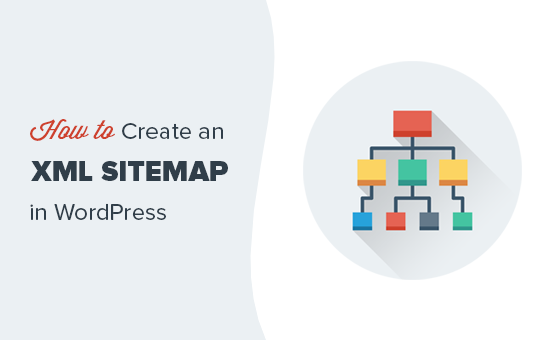
¿Qué es un mapa del sitio XML?
Un mapa del sitio XML es un archivo que enumera todo el contenido de su sitio web en formato XML para que los motores de búsqueda como Google puedan descubrir e indexar fácilmente su contenido.
A principios de la década de 2000, los sitios web gubernamentales solían tener un enlace en sus páginas principales titulado “Mapa del sitio”. Esta página solía contener un anuncio / catálogo / ficha de todas las páginas importantes de ese sitio web.
Aunque algunos sitios web siguen teniendo páginas de mapas del sitio en HTML, el uso general de los mapas del sitio ha evolucionado con los años.
Hoy en día, los mapas del sitio se publican en formato de archivo XML en lugar de HTML, y su público objetivo son los motores de búsqueda y no las personas.
Básicamente, un mapa del sitio XML es una forma que tienen los propietarios de sitios web de informar a los motores de búsqueda acerca de todas las páginas que existen en su sitio web.
También indica a los motores de búsqueda qué enlaces son más importantes que otros y con qué frecuencia actualiza su sitio web.
Aunque los mapas del sitio XML no mejorarán su posicionamiento en los motores de búsqueda, permiten que éstos rastreen mejor su sitio web. Esto significa que pueden encontrar más contenido y empezar a mostrarlo en los resultados de búsqueda, lo que se traduce en más tráfico de búsqueda y una mejora de la clasificación SEO.
Por qué necesita un mapa del sitio XML
Los mapas del sitio son extremadamente importantes desde el punto de vista de la optimización para motores de búsqueda (SEO ).
La simple adición de un archivo de mapa del sitio no afectará a su clasificación en las búsquedas. Sin embargo, si hay una página en su sitio que no está indexada, un mapa del sitio permitirá que los motores de búsqueda sepan acerca de esa página.
Los mapas del sitio son muy útiles cuando se empieza un blog o se crea un sitio web nuevo, porque la mayoría de los sitios web nuevos no tienen vínculos de retroceso. Esto hace que sea más difícil para los motores de búsqueda descubrir todo su contenido.
Por este motivo, los motores de búsqueda como Google y Bing permiten a los propietarios de sitios web nuevos enviar un mapa del sitio en sus herramientas para webmasters. Esto permite a los robots de los motores de búsqueda descubrir e indexar fácilmente su contenido (más información sobre este tema más adelante).
Los mapas del sitio también son importantes para los sitios web populares ya establecidos. Permiten destacar qué partes de su sitio web son más importantes y cuáles se actualizan con más frecuencia para que los motores de búsqueda puedan indexar su contenido en consecuencia.
Dicho esto, veamos cómo crear un mapa del sitio XML en WordPress.
Tutorial en vídeo
Si prefiere instrucciones escritas, siga leyendo.
Existen varias formas de crear un mapa del sitio XML en WordPress. Le mostraremos tres métodos populares para crear un mapa del sitio XML en WordPress. También le mostraremos cómo enviar sus mapas del sitio a los motores de búsqueda y utilizarlos para hacer crecer su sitio.
Método 1: Crear un mapa del sitio XML en WordPress sin plugins
Este método es muy básico y limitado en cuanto a características.
Antes de agosto de 2020, WordPress no tenía mapas del sitio integrados. Sin embargo, en WordPress 5.5, lanzaron una característica básica de mapa del sitio XML.
Esta característica le permite crear automáticamente un mapa del sitio XML en WordPress sin necesidad de utilizar un plugin. Sólo tienes que añadir wp-sitemap.xml al final del nombre de tu dominio, así:
https://www.example.com/wp-sitemap.xml
WordPress le mostrará el mapa del sitio XML por defecto.
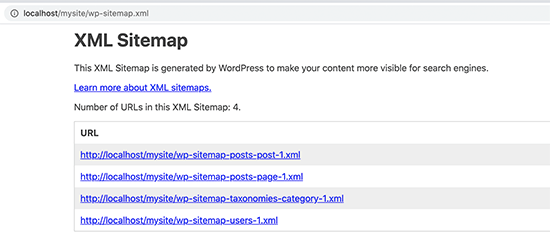
Esta característica de mapa del sitio XML se añadió a WordPress para garantizar que cualquier sitio web nuevo de WordPress no se pierda las ventajas SEO de un mapa del sitio XML.
Sin embargo, no es muy flexible y no se puede controlar fácilmente qué añadir o eliminar de los mapas del sitio XML.
Por suerte, casi todos los mejores plugins SEO para WordPress vienen con su propia funcionalidad de mapa del sitio. Estos mapas del sitio son mejores, y puedes controlar qué contenido quitar / excluir de tus mapas del sitio XML de WordPress.
Método 2: Crear un mapa del sitio XML en WordPress con AIOSEO
La forma más sencilla de crear un mapa del sitio XML en WordPress es utilizando el plugin All in One SEO (AIOSEO) para WordPress.
Es el mejor plugin SEO para WordPress del mercado, que le ofrece un generador de mapas del sitio y un completo conjunto de herramientas para optimizar las entradas de su blog para SEO.
En primer lugar, debe instalar y activar el plugin All in One SEO. Para más detalles, consulte nuestra guía paso a paso sobre cómo instalar un plugin de WordPress.
La característica del mapa del sitio también está disponible en la versión gratuita de AIOSEO. Sin embargo, para obtener mapas del sitio de noticias avanzadas y mapas del sitio de vídeo, necesitará la versión Pro.
Una vez activado, vaya a la página Todo en Uno SEO ” Sitemaps para establecer los ajustes del mapa del sitio.
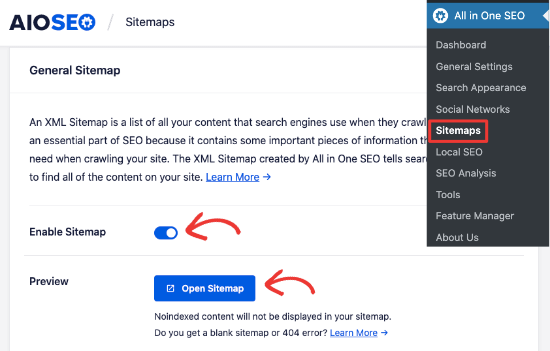
Por defecto, All in One SEO activará la característica del mapa del sitio para usted y reemplazará los mapas del sitio básicos de WordPress.
Puede hacer clic en el botón “Abrir mapa del sitio” para ver una vista previa de su aspecto. También puede ver su mapa del sitio añadiendo sitemap.xml a la URL de su sitio web, por ejemplo:
https://www.example.com/sitemap.xml
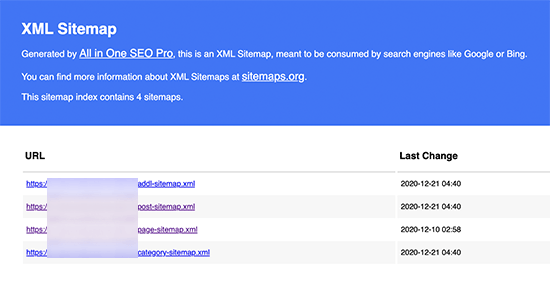
Como principiante, no necesitas hacer nada, ya que los ajustes por defecto funcionarán para todo tipo de sitios web, blogs y tiendas online.
Sin embargo, puede personalizar los ajustes del mapa del sitio para controlar lo que desea incluir en su mapa del sitio XML.
Sólo tiene que desplazarse hasta la sección “Ajustes del mapa del sitio”.
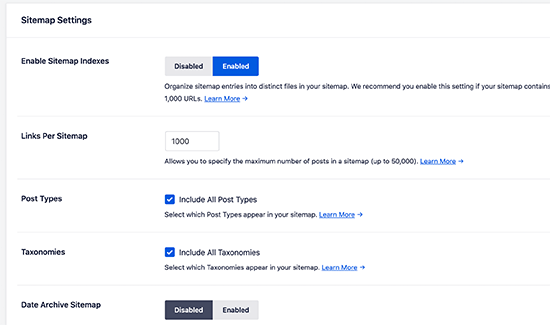
Esta sección le ofrece opciones para gestionar los índices del mapa del sitio e incluir o excluir tipos de entradas y taxonomías(categorías y etiquetas). También puede activar mapas del sitio XML para archivos basados en fechas y archivos de autor.
All in One SEO incluye automáticamente todo el contenido de WordPress en los mapas del sitio XML. Pero, ¿y si tienes páginas independientes como un formulario de contacto, una página de destino o páginas de tiendas Shopify que no forman parte de WordPress?
Pues bien, AIOSEO es el solo plugin que te permite añadir páginas externas a tu mapa del sitio de WordPress. Simplemente desplázate hasta la sección ‘Páginas adicionales’ y actívalo. Esto te mostrará un formulario donde puedes añadir cualquier página personalizada que quieras incluir.
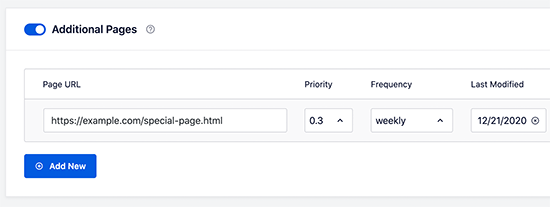
Sólo tiene que añadir la URL de la página que desea incluir y, a continuación, establecer una prioridad en la que 0,0 es la más baja y 1,0 la más alta. Si no está seguro, le recomendamos que utilice 0,3.
A continuación, elija la frecuencia de las actualizaciones y la fecha de la última modificación de la página.
Puede hacer clic en el botón “Añadir nuevo” si necesita añadir más páginas.
No olvides hacer clic en el botón “Guardar cambios” para establecer los ajustes.
Excluir entradas y páginas específicas de su mapa del sitio XML
All in One SEO le permite excluir cualquier entrada o página de sus mapas del sitio XML. Puede hacerlo al hacer clic en la sección ‘Ajustes avanzados’ en la página All in One SEO ” Sitemaps.
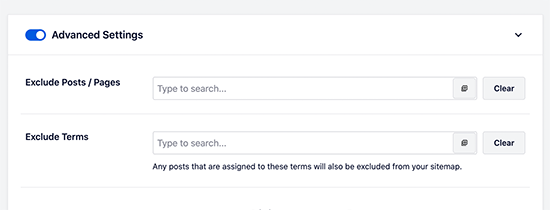
También puede quitar / eliminar una entrada o página de sus mapas del sitio XML haciendo que sea no-index y no-follow. Esto impedirá que los motores de búsqueda muestren ese contenido en los resultados de búsqueda.
Simplemente edite la entrada o página que desea excluir y desplácese hasta el cuadro de ajustes de AIOSEO situado debajo del editor.
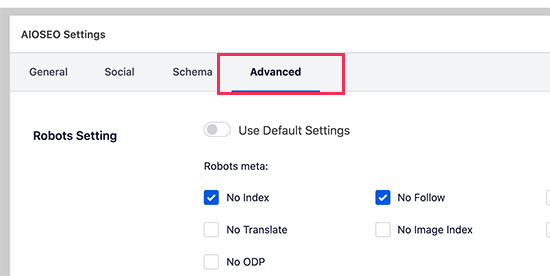
Desde aquí, debe cambiar a la pestaña Avanzado y marcar las casillas siguientes a las opciones “Sin índice” y “Sin seguimiento”.
Creación de mapas del sitio adicionales
All in One SEO le permite crear mapas del sitio adicionales, como un mapa del sitio de vídeo o de noticias.
Puede crear un mapa del sitio de vídeo si incrusta vídeos regularmente en las entradas o páginas de su blog. Esto permitirá que los motores de búsqueda muestren las entradas en los resultados de búsqueda y de búsqueda de vídeos junto con una miniatura del vídeo.
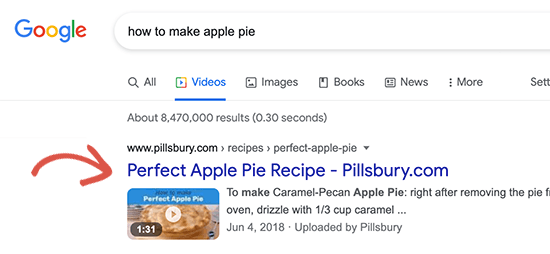
También puedes crear un mapa del sitio de noticias si diriges un sitio web de noticias y quieres aparecer en los resultados de búsqueda de Google Noticias.
Simplemente vaya a All in One SEO ” Sitemaps y cambie a las pestañas Mapa del sitio de vídeo o Mapa del sitio de noticias para generar estos mapas del sitio.
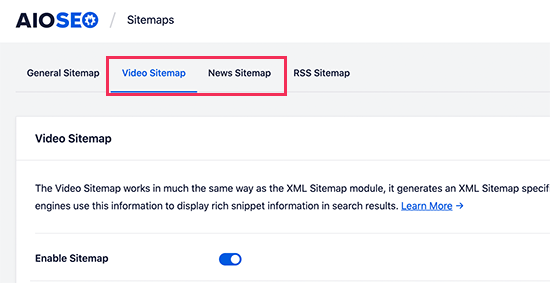
En general, AIOSEO es el mejor plugin para WordPress porque te ofrece toda la flexibilidad y potentes características a un precio muy asequible.
Método 3: Creación de un mapa del sitio XML en WordPress con Yoast SEO
Si utiliza Yoast SEO como plugin de SEO para WordPress, también activará automáticamente los mapas del sitio XML.
En primer lugar, debes instalar y activar el plugin Yoast SEO. Para más detalles, consulta nuestra guía paso a paso sobre cómo instalar un plugin de WordPress.
Una vez activado, vaya a la página SEO ” General y cambie a la pestaña ‘Características’. A continuación, desplácese hasta la opción “Mapa del sitio XML” y asegúrese de que está activada.
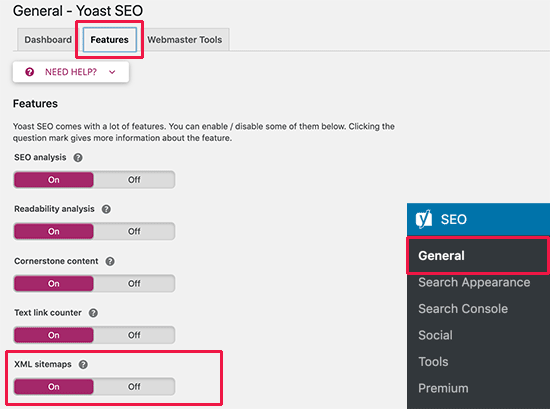
A continuación, haz clic en el botón “Guardar cambios” para guardarlos.
Para comprobar que Yoast SEO ha creado un mapa del sitio XML, puede hacer clic en el icono con forma de interrogación situado al lado de la opción “Mapas del sitio XML” de la página.
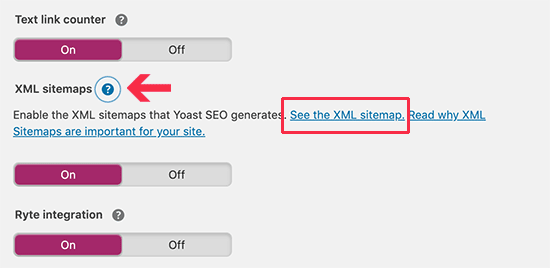
Después de eso, haga clic en el enlace “Ver el mapa del sitio XML” para ver su mapa del sitio XML en vivo generado por Yoast SEO.
También puede encontrar su mapa del sitio XML simplemente añadiendo sitemap_index.xml al final de la dirección de su sitio web. Por ejemplo:
https://www.example.com/sitemap_index.xml
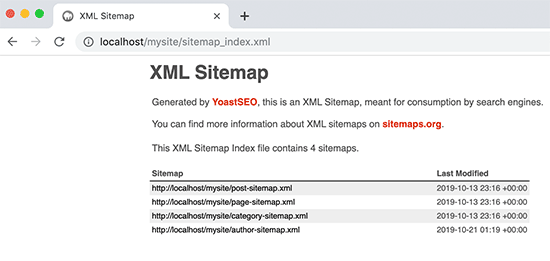
Yoast SEO crea múltiples mapas del sitio para diferentes tipos de contenido. Por defecto, generará mapas del sitio para entradas, páginas, autores y categorías.
Envío del mapa del sitio XML a los motores de búsqueda
Los motores de búsqueda son bastante inteligentes a la hora de encontrar un mapa del sitio. Cada vez que publica nuevo contenido, se envía un ping a Google y Bing para informarles acerca de los cambios en el mapa del sitio.
Sin embargo, le recomendamos que envíe el mapa del sitio manualmente para asegurarse de que los motores de búsqueda puedan encontrarlo.
Envío del mapa del sitio XML a Google
Google Search Console es una herramienta gratuita que ofrece Google para ayudar a los propietarios de sitios web a supervisar / seguir / vigilar la presencia de su sitio en los resultados de búsqueda de Google.
Si añades el mapa del sitio a Google Search Console, el sistema descubrirá rápidamente tu contenido, incluso si tu sitio web es nuevo.
En primer lugar, debes visitar el sitio web de Google Search Console y acceder a una cuenta.
A continuación, se le pedirá que seleccione un tipo de propiedad. Puede elegir un dominio o un prefijo URL. Le recomendamos que elija un prefijo URL, ya que es más fácil de establecer.
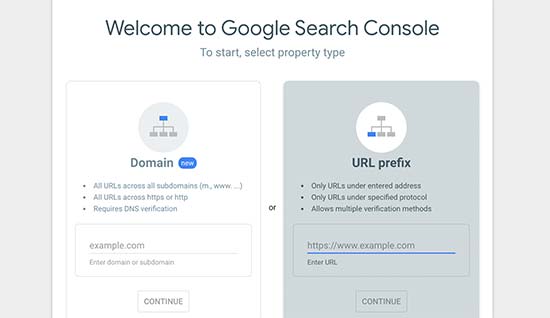
Introduzca la URL de su sitio web y haga clic en el botón “Continuar”.
A continuación, se le pedirá que verifique la propiedad del sitio web. Verá varios métodos para hacerlo. Le recomendamos que utilice el método de la etiqueta HTML.
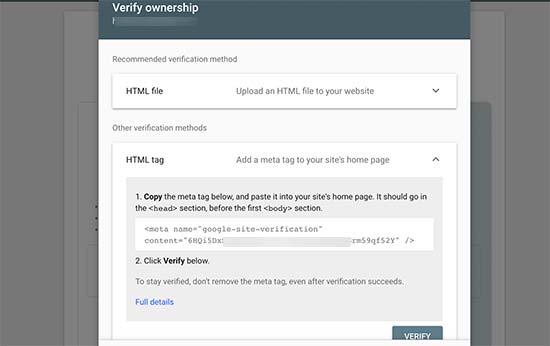
Sólo tiene que copiar el código que aparece en la pantalla y luego ir a la zona de administrador de su sitio web WordPress.
Si está utilizando AIOSEO, entonces viene con una fácil verificación de herramientas para webmasters. Simplemente ve a Todo en Uno SEO ” Ajustes Generales y luego haz clic en la pestaña ‘Herramientas para webmasters’. A continuación, introduzca el código de Google.
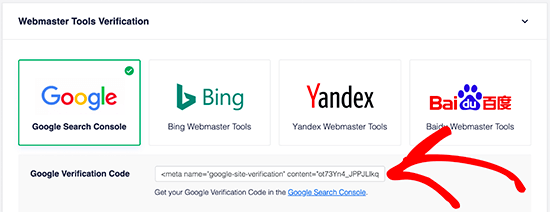
Si no utiliza AIOSEO, puede introducir el código utilizando el plugin WPCode. Esta es la forma más segura y fácil de añadir código a su sitio de WordPress.
Necesitas instalar y activar el plugin gratuito WPCode. Para más detalles, consulta nuestra guía paso a paso sobre cómo instalar un plugin de WordPress.
Una vez activado, debe visitar la página Fragmentos de código ” Cabecera y pie de página y añadir el código que ha copiado anteriormente en la casilla “Cabecera”.
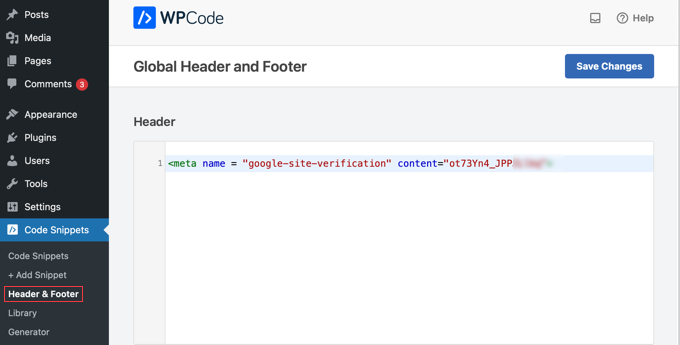
No olvides hacer clic en el botón “Guardar cambios” para guardar las modificaciones.
Ahora, vuelve a la pestaña de Google Search Console y haz clic en el botón “Verificar”.
Google comprobará si hay un código de verificación en tu sitio y, a continuación, lo añadirá a tu cuenta de Google Search Console.
Nota: Si la verificación no se realiza correctamente, asegúrese de vaciar la caché de WordPress y vuelva a intentarlo.
Ahora que ha añadido su sitio web, vamos a añadir también su mapa del sitio XML.
Desde el Escritorio de su cuenta, tiene que hacer clic en “Sitemaps” en la columna de la izquierda.

A continuación, añada la última parte de la URL del mapa del sitio en la sección “Añadir un nuevo mapa del sitio” y haga clic en el botón “Enviar”.
Google añadirá la URL del mapa del sitio a Google Search Console.
Google tardará algún tiempo en rastrear su sitio web. Después de un tiempo, podrás ver las estadísticas básicas del mapa del sitio.
Esta información incluye el número de enlaces que Google ha encontrado en el mapa del sitio, cuántos de ellos se han indexado, la proporción entre imágenes y páginas web, etc.
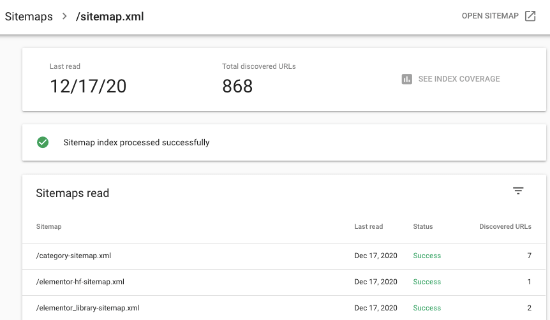
Envío del mapa del sitio XML a Bing
De forma similar a Google Search Console, Bing también ofrece Bing Webmaster Tools para ayudar a los propietarios de sitios web a supervisar / seguir / vigilar su sitio web en el motor de búsqueda de Bing.
Para añadir el mapa del sitio a Bing, debe visitar el sitio web Herramientas para webmasters de Bing.
Aquí verás dos opciones para añadir tu sitio. Puede importar su sitio desde Google Search Console o añadirlo manualmente.
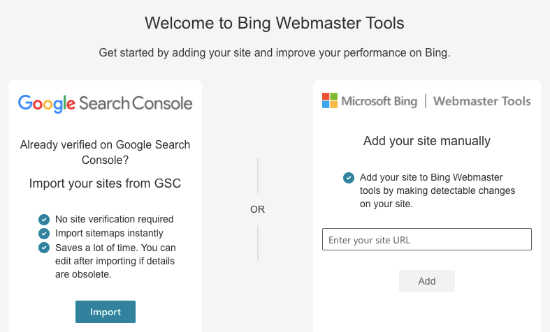
Si ya has añadido tu sitio a Google Search Console, te recomendamos que lo importes. Le ahorrará tiempo, ya que el mapa del sitio se importará automáticamente.
Si decide añadir su sitio manualmente, deberá introducir la URL de su sitio y verificar el sitio.
Bing le pedirá ahora que verifique la propiedad de su sitio web y le mostrará varios métodos para hacerlo.
Recomendamos utilizar el método de la meta etiqueta. Simplemente copie la línea de la meta etiqueta de la página y diríjase a su escritorio de WordPress.
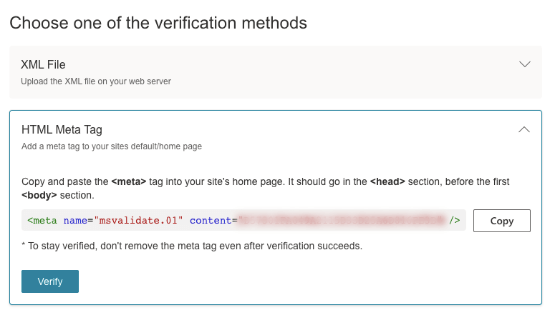
Ahora, instala y activa el plugin WPCode Free en tu sitio web
Una vez activado, debe visitar la página Fragmentos de código ” Cabecera y pie de página y añadir el código que ha copiado anteriormente en la casilla “Cabecera”.
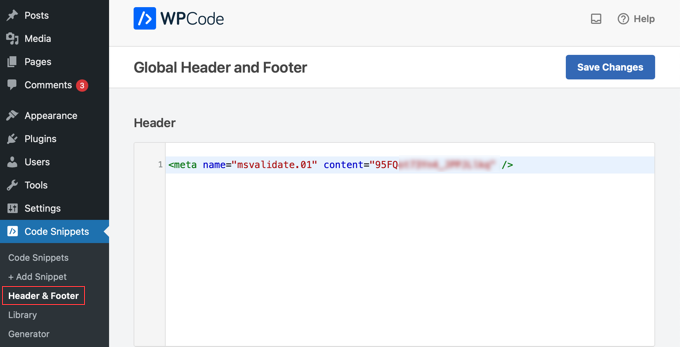
No olvides hacer clic en el botón “Guardar cambios” para guardar las modificaciones.
Uso de mapas del sitio XML para hacer crecer su sitio web
Ahora que ya ha enviado el mapa del sitio XML a Google y Bing, veamos cómo utilizarlo para su sitio web.
En primer lugar, debe tener en cuenta que el mapa del sitio XML no mejora su clasificación en los motores de búsqueda. Sin embargo, sí ayuda a los motores de búsqueda a encontrar contenido, ajustar la tasa / tarifa de rastreo y mejorar la visibilidad de su sitio web en los motores de búsqueda.
Debe consultar las estadísticas de su mapa del sitio en Google Search Console. Puede mostrarte los errores de rastreo y las páginas excluidas de la cobertura de búsqueda.
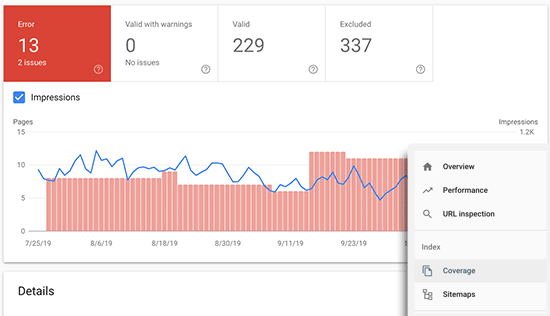
Debajo de los gráficos, puede hacer clic en las distintas tablas.
Aquí puede ver las URL reales que Google ha excluido o no ha indexado.
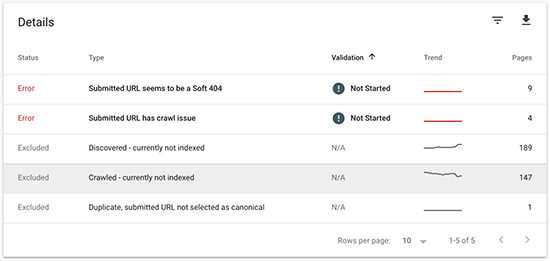
Normalmente, Google puede decidir omitir el contenido duplicado, las páginas sin contenido o con muy poco contenido y las páginas excluidas por el archivo robots.txt o las metaetiquetas de su sitio web.
Sin embargo, si tiene un número inusualmente alto de páginas excluidas, puede que quiera marcar / comprobar los ajustes de su plugin SEO para asegurarse de que no está bloqueando ningún contenido.
Para obtener más información, consulta nuestra guía completa de Google Search Console para principiantes.
Esperamos que este artículo te haya ayudado a aprender sobre los mapas de sitio XML y cómo crear un mapa de sitio XML para tu sitio de WordPress. También puedes consultar nuestra guía sobre cómo crear un mapa del sitio multilingüe en WordPress y nuestra selección de las mejores herramientas de búsqueda de palabras clave para escribir mejores contenidos.
If you liked this article, then please subscribe to our YouTube Channel for WordPress video tutorials. You can also find us on Twitter and Facebook.




Bikramjit Singh
Thank You! These small things such as issue when needed urgently.Thanks a lot for the article.
Saikot Hc
Thanks bro because share this plugin.
marshall
thanks a ton!!! its awesomely written
Anatoly Khalizev
Thank you very much for such delailed explanation. It is very useful!
Adrian
My Site Map URL returns a 404 :/ anyone knows why this is? I already followed the steps to get it
Santhosh Veer
how to edit this sitemap?
WPBeginner Staff
You will have to verify your owner ship of the site by adding a meta tag or uploading a file to your web server.
Shamim Gypsy
Thanks for your reply. Will it harmful for the site if I verify the site with new email ID?
Grayson Carter
Its not harmful to the site from an SEO perspective, however, if your boss has already verified the site under his account, you’ll loose all historical data under his account. The best solution would be for him to add you as an administrator for that site in GWT and then you can see all the historical data he’s collected and you can still handle submitting a site map
Shamim Gypsy
My boss already have a webmaster account. He did not add xml site map. But now I want to add site map without his webmaster account. that means I want to add site map with my email webmaster account. Is it possible to use double webmaster account for one site?
Tholi
How do I make my site maps appear on one page under my domain name?
Taylor Thompson
Great post! Thank you for all of the helpful information However, I still have a few questions. Why does Google index only some of the pages you submit with a sitemap? Also, I see that you have images indexed. I have numerous images on my site, and none of them were indexed. Is there a separate process to index images?
However, I still have a few questions. Why does Google index only some of the pages you submit with a sitemap? Also, I see that you have images indexed. I have numerous images on my site, and none of them were indexed. Is there a separate process to index images?
Thank you!
Yatin
I have uploaded sitemap_index.xml on webmaster. My first blog was seen on the google search. But my other posts are not getting indexed. What is the reason behind it? Do we need to add post-sitemap.xml or category-sitemap.xml individually then?
sudan
do i need to submit sitemap offten on google webmaster tool ? becuase my new post still not count
WPBeginner Staff
No you don’t need to.
WPBeginner Staff
Yes.
nazifa mazni
if I already setup xml sitemap from wordpress seo yoast. do I need uninstall plugin Dagon Design Sitemap Generator, google sitemap and google xml sitemap?
Lencho
followed your instructions and when I clicked on the “You can find your XML Sitemap here: XML Sitemap” it took me to this error mesage:
“Not Found
Sorry, but the page you were trying to view does not exist.
It looks like this was the result of either:
a mistyped address
an out-of-date link”
Now what?
Thanks
KC Wong
I follow the steps as per video, when click “xml sitemap”, it shows 404 rather than the list. How can I improve it?
Geoff
In the Yoast SEO plugin settings for XML sitemaps, untick the box for “Check this box to enable XML sitemap functionality.”, SAVE, then tick the box and SAVE again. This got everything working for me after much reading and not finding any answers. Many people seem to be having this issue so I hope this helps someone.
calmberay141182
thanks
Edwin Juma
Thanks alot! my new site is now working well.
D Donaldson
Helped me more than anything I have found in the very difficult endeavor of selfing a site. Thank you. Owe you one.
Ankit Jha
I want to edit the XML file created by SEO by Yoast Plugin. Where can I find the file?
Walter Mrowczynski
Pretty sure any change you make will be overwritten whenever you make a new page/post.
TheRookieUser
Thank you! I have a new site and your tips really works well for me
Have a great day!
Keith Davis
Thanks guys
I’m just looking at the Yoast SEO plugin and I’m checking out info on XML sitemaps.
As ever you guys nail it.
Marlon Buenaventura
Hi! My homepage title duplicates, what was the reason behind it? How can I fix the error? Please help! Thanks!
susielindau
Does this work for .com sites? if not, what can I do to make my site easy to crawl?
Max
Very good . I love this. Helpful.
Thanks from Thailand.
Tina
Thank you for this article. I had just assumed the sitemap was pulled once I verified my site. Great article & thanks for teaching me. You’re my #1 stop to find out information.
micheal
Nice post. Was able to set my sitemap in seconds thanks to your wonderful tutorial.
Dennis West
Yoast WordPress SEO: XML Sitemaps
I am getting an error when I click on the XML Sitemap button
—-
Not Found
The requested URL /sitemap_index.xml was not found on this server.
Additionally, a 404 Not Found error was encountered while trying to use an ErrorDocument to handle the request.
Apache/2.2.24 (Unix) mod_hive/3.6 mod_ssl/2.2.24 OpenSSL/0.9.8e-fips-rhel5 mod_auth_passthrough/2.1 mod_bwlimited/1.4 FrontPage/5.0.2.2635 mod_jk/1.2.35 Server at designresidential.biz Port 80
Katrina Cliffe
I am also getting this error? Did you manage to fix it?
Jane Barlow
Wish I’d have found this hours and hours ago. My site is now validated thanks to your easy to follow guidelines.
Most appreciated with heartfelt thanks.
Ian
Great article. Thank you!
It’s taken me ages until now, but up and running.
Quizvook
Awesome post,i created my site sitemap using this method thanks a lot for sharing Syed Balkhi.
mike jefferies
Used Yoast WP SEO, it took time but pleased to say succeeded, which I put down to WP4B well explained “idiots guide” (no disrespect to anyone..merely applies to me). Many thanks guys, you haven’t failed yet.
wajid khan
Hi, great article about sitemaps. Mind me asking that if i am using a plugin like seo by yoast, which creates multiple sitemaps how can i achieve what you have mentioned above?
WPBeginner Support
In this article we did show how to do this using WordPress SEO plugin. However, if you are using some other plugin to generate sitemaps. Then make sure your sitemaps are publicly accessible and then submit the sitemap URL in Google Webmaster Tools.
Admin
Larry Woods
Good article. Too bad Yoast doesn’t generate a sitemap on my site! And, judging from the number of complains on the WP forum there are others that are having the same problem. The frustrating thing is that when you press the “XML Sitemap” button it displays a sitemap. It just doesn’t create it.
Mauritz Mostert
A valid statement Larry. I am sorry you didn’t get an answer because I have been puzzling about exactly what you refer to. When I click on the “XML Sitemap” button in Yoast I get nothing! Only a blank page.
I have 24 Posts and 62 pages in just under a year, all submitted to Google myself. I have submitted my sitemap five times for almost a year to Google Webmaster Tools and the result is still 7 submitted and 5 indexed. I can’t understand how that works?
I don’t even have a sitemap displayed, never mind created by Yoast. There is no way to cross-reference Yoast to see if the job is indeed done or not… sad.
Reyansh
once again excellent article.
falling in love with wpbeginner.:)
Avinash
Hi,
Google webmaster tools showing error as on sitemp being the sitemap is a html.
Works fine on my 2nd site, but not on the 1st site.
I’ve tried suggestion given on Yoast.com about adding the sitemap to the exclusion list on using W3Total Cache plugin. Error still persists.
Any other suggestion would be helpful.
Jennifer Ebeling
Awesome post! Thank you!
Andy Peck
What a brilliantly clear article – very easy to use and run through. many thanks
Chris Lovie-Tyler
Thanks, this was helpful to me. Yoast’s WordPress SEO is a great plugin.
Abdullah Abduragmaan
Please can you advise if it is possible to stop non-search engines from accessing the site map?
OR if one can change the path of the files or something. I am concerned scrapers will get access to the sitemap.
Editorial Staff
Not unless you modify the plugin. Scrapers will scrape your content regardless. They don’t need RSS for that.
Admin
Michael Dimas
NICE POST !!! (y)
Anshar
If i install wordpress in the directory (not in the root) ex. http://www.mydomain.com/blog/
where is the place to submit the sitemap page? after domain like mydomain.com/sitemap.xml or after the directory where i install wordpress on it, like mydomain.com/blog/sitemap.xml
Editorial Staff
it will be in yourdomain.com/blog/sitemap.xml
Admin
Rose
Hi
I am kind of new. 2 questions to ask
1. How frequent should we submit our sitemap, is it necessary to submit each we created a new post.
2. do we need to submit sitemaps all including those related to categories, tags, pages number or just purely the blog posts?
Thanks
Editorial Staff
You only submit your sitemap once. After that your sitemap does the job of updating search engines
Admin
Rose
Thanks for the enlightment
MJ
It appears that Editorial Staff is busy somewhere…..
MJ
Hi,
With reference to my previous comment can you please answer my query. When i type my site name in Google, it shows the last update as 3 or 4 days old. I tried different setting of Yoast WordPress SEO plugin but i couldnt’ find anything that could resolve it.
I am sceptical that my posts are not reaching to Google on time. I check the sitemap and found that ‘Post Priority’ of all the posts as ‘60%’. Can it be changed to 100% without manually editing it from “Yoast admin area in Post”? Is this priority factor actually is the reason behind outdated update in Google Search result as mentioned above…?
MJ
I am using WP SEO by Yoast but interestingly my site map vanishes from the Google Webmaster Dashboard and it starts showing ‘0’ URL submitted. When i click on this section to go into detail, i find “/sitemap_index.xml” as “Pending”.
It happens most of the time in a week and i have to resubmit it again and again. What is the solution to this?
Secondly when i search my site in Google, it shows updated time as 2 or 3 or sometimes 4 days ago whereas, the site is updated every day. This is all happening since i have installed WP SEO by Yoast.
Yoast does not respond to such queries, i thought i would get a solution here….
Nikunj
Thanks for enlighten us I want to ask one question that We should include our categories in sitemap or Posts in sitemap which one should be at higher priority POST or CATEGORY ? plz tell
Editorial Staff
WordPress SEO by Yoast gives you the option to choose whether you want to add categories, tags, other taxonomies in your sitemap or not. We have our categories in the sitemap. Posts should always have a higher priority over the archive pages just because most folks usually land on your single post pages rather than archive pages.
Admin
David
Thank you, that was a useful post. I’ve been wondering if it’s necessary to post Yoast’s sitemap to the WT area.
Editorial Staff
It’s not necessary, but it will help you see if there are any errors and such.
Admin
David
So does a bot know to look for that map? Or is Yoast’s plugin actually submitting it anyway?
Editorial Staff
To get the best results and confirmation that the bot is actually seeing your sitemap, you should submit the sitemap in Google.
Keith Davis
Hi Syed
I submit a sitemap to Google via Webmaster tools and my sitemap is a simple .txt file.
Each time I write a post I add it to the sitemap and resubmit.
Only takes two minutes and it’s part of the SEO I carry out for each post / page.
Would I be better off going with an XML sitemap?
Travis Shak
Hey Keith,
You definitely would be better off using an XML sitemap. Its a no brainier. With the Yoast SEO plugin, your sitemaps will be automatically generated which leaves more time to work on the important things.
Editorial Staff
Agreed
Admin
Keith Davis
Just getting round to using the Yoast SEO plugin.
Umer Rock
I understood Sitemap but facing a strange issue with wp seo by yoast plugin, when we go for scan our website with any seo online tool, in report show this sitemap.xml not found blah blah,
because WP seo by yoast make like domain.com / post_sitemap.xml etc. any solution..
Editorial Staff
Those SEO tools don’t know any better.
Admin
Gautam Doddamani
exactly those seo tools are taking sitemap.xml as the url and not post_sitemap….since yoast maintains a wide variety of sitemaps such as for video, pages, categories and tags…we get the post sitemap url for posts!!